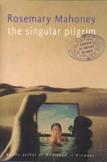Spectacleand Silence
Rosemary Mahoney is a good traveler and a good writerinterested, interesting and strikingly unconventional in her perceptions. In earlier books, she has allowed us to listen to people in China (The Early Arrival of Dreams) and Ireland (Whoredom in Kimmage, a 1994 National Book Critics Circle Award finalist). In The Singular Pilgrim her canvas is the pilgrimage, that act which concerns the relationship of the individual self to God, beyond the standard rituals of a religious institution.
Like all travelers, Rosemary Mahoney brings along her own religious and personal history, idiosyncracies, temperament, losses and longings. She is honest about her ambivalence toward the church but is wise enough to keep her focus on her holy travels and not on herself. Part of this restraint is, I suspect, due to the influence of her mother, a remarkable woman who survived a childhood bout with polio (two siblings died) and the residual paralysis; widowed early, she was left to raise seven children alone. Hers is the eloquent voice of the sober Catholic (I believe in God, I live by the cross), with her bracing, fervent belief in the Eucharist and embrace of the discipline of religion. Her lack of sentimentality is an effective counterpoint to the heightened emotionalism of some pilgrims.
The other thing that orients Rosemary Mahoney outward is her healthy curiosity about pilgrimage as a religious phenomenon in a secular age. Only one pilgrimage goalVaranasi, the city on the Ganges sacred to devout Hindusis non-Christian. The others (Walsingham, Lourdes, El Camino de Santiago, the Holy Land and St. Patrick’s Purgatory) elicit distinct questions that reflect aspects of Christian faith and history and nuances of its spiritual tradition.
While I had hoped for a more robust intellectual framework that would elucidate the theological issues that begged to be addressed, it would be unfair to ask that of a book that belongs to the more modest genre of travel literature. In some ways, this book is analogous to a pilgrimage. As Mahoney so ably shows, one sets out on pilgrimage but cannot predict what will be foundindeed, noble intent seems difficult to sustain when the pilgrim’s attention is necessarily focused on the dangers, fatigue and sheer physicality required of this religious act. The pilgrim is surprised and transformed by the act of pilgrimage.
The author seems to falter in Varanasi, perhaps because its religious language is so foreign to her fluency in the Christian one. The prose wanders, as Mahoney herself did through the city, trying but failing to grasp its import and its understanding of death. The chapter is saved, though, by its loving portrait of 16-year-old Jaga, the remarkably engaging young man who is her guide. It is only in a rare, unguarded conversation, as though making a confession, that this preternaturally mature soul tells her about the deaths, within one month, of his three-year-old sister and five-year-old brother.
Mahoney has long been captivated by the human Jesus, and her days wandering in the hills outside of Nazareth elicit ruminations on his courage and loneliness. She offers the novel idea that, despite the varied ways Jesus has been presented to us throughout history, he was never ugly. Why Christ should not be ugly was significant only in that it revealed the universal vanity and prejudice of the human mind. A savior worthy of us couldn’t possibly have been homely.
Whether or not that is an accurate perception about Jesus, it is an apt metaphor for the pilgrimages that are described in this book. That they reveal as much about us, our vanity and prejudice, as they do about God is attested to in descriptions of competing interests at holy sites in Nazareth and Jerusalem and the anti-Catholic demonstrators at the Anglican pilgrimage to Walsingham, who shout about the Romish practice of worshiping false idols.
The book ends with the precision and intricacy of the rigorous penitential exercise of St. Patrick’s Purgatory. The sense of shared hardship, the extremeness of it, made everyone feel close and understood. A disparate community of pilgrims had made themselves humble, and in their humility they were fierce. They were on their knees but they were bold enough to call God down. It was a strange, defiant, ancient practice. It is tempting to cling to the hope that some day, our equally disparate human community, bound together by the suffering endemic to our finite, contingent lives, will unite in such a fierce humility of worship.
This is not a perfect book, and, perhaps because of the author’s distance from Catholicism, it lacks the spiritual maturity that a more conventional believer (perhaps her mother) would bring to the exercise. Nonetheless, in a time when religion and violence are so intimately linked, there is something hopeful about this modest look at a deeply human religious practice that is, at the same time, a suitable vehicle for worship.
Mahoney gives us not only the spectacle of pilgrimage, but also its quieter, more intimate moments. She tells of her meeting with Agnes and her daughter Carla (unlikely to live beyond her seventeenth birthday). This is their third trip to Lourdes, Agnes explains, but I don’t come...for a cure. I come out of gratitude for the lovely girl I’ve been given.
In the end, perhaps pilgrimages exist for no other reason than that there be places in this world where such luminous prayers can be offered.
This article also appeared in print, under the headline “Spectacleand Silence,” in the May 26, 2003, issue.








